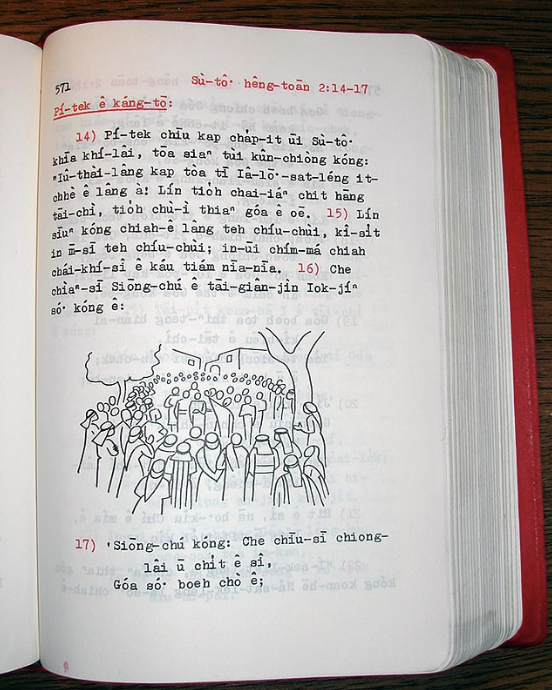Before 1945, the most widely spoken language in Taiwan was Tâi-gí (also known as Taiwanese [台語] or Taiwanese Hokkien). It was used across many of Taiwan’s ethnic communities, especially Taiwan’s ethnic majority population (sometimes referred to as the “Holo” or “Hoklo” population). However, due to almost a century of language repression policies, Tâi-gí use has declined sharply. Over 60 percent of Taiwanese people believe Tâi-gí is at risk of becoming endangered, but only 37.2 percent of Taiwanese believe the Ministry of Education’s (教育部) efforts are enough to save Taiwan’s “heritage languages,” including Tâi-gí. [1] Despite Tâi-gí’s former status as Taiwan’s de facto national language, there is little contemporary political effort, even from the Democratic Progressive Party (DPP, 民進黨), to incorporate it in public life. Indeed, it was not until 2019 that Taiwan launched a public television channel using primarily Tâi-gí, which recently saw its budget slashed.
Linguist Kenneth Hale once said, “Losing any [language] is like dropping a bomb on the Louvre.” To understand Taiwan’s Tâi-gí crisis, I talked with six Tâi-gí scholars and activists from Taiwan and the United States. Together, we discussed the history of Tâi-gí repression from Japanese colonization to martial law, the major challenges faced by current-day activists trying to preserve the language, and lastly new, creative policy suggestions and program ideas for revitalizing Tâi-gí.
Language Repression in Taiwan
Tâi-gí language repression began when Japan acquired Taiwan in 1895 after winning the First Sino-Japanese War. The Japanese believed that only their language–a “modern” language–could spread “modern” ideas and instill the superiority of Japanese culture. Nevertheless, flexibility in Japan’s language policies allowed a nascent Taiwanese Language Movement to emerge. The father of Tâi-gí, Ông Io̍k-tek (王育德), taught Tâi-gí at Meiji University in Japan, where he also wrote articles pushing for acceptance of Taiwanese language, culture, and sovereignty.
During the Kuomintang (KMT, 國民黨) martial law period from 1949 to 1987, language policies became stricter. When the KMT arrived in Taiwan, most Taiwanese people did not speak Mandarin. They spoke Japanese and/or a heritage language like Hakka or Tâi-gí. However, to uphold the legitimacy of the “Republic of China,” the KMT required that only Mandarin be used in public life, including in classrooms, government announcements, and on TV. “Mainlanders” (外省人) who came with the KMT to Taiwan touted their Mandarin fluency as superior over “native” Han Taiwanese (本省人). As a result, Holo parents stopped teaching their children Tâi-gí to protect them from being bullied or punished.
Lim Cheng-iu (林貞佑), a Tâi-gí scholar from National Cheng Kung University (國立成功大學), observed that during martial law, Tâi-gí preservation efforts were most visible in the United States, where overseas Taiwanese were free from the KMT’s language ban. Lim’s research revealed that since language was one of the only things Taiwanese migrants could carry with them from their homeland, it became a key way for them to “stay rooted in a new land.” Taiwanese Americans attempted several times to start monthly Tâi-gí publications, with the latest one—Tâi-bûn Thong-sìn BONG Pò (a merger of the US-based Tâi-bûn Thong-sìn and Taiwan-based Tâi-bûn Bong-Pò)—still in publication today. They also congregated to hear Tâi-gí church sermons on Sundays. Through everyday conversation, they preserved vocabulary that was forgotten in Taiwan. Professor Shih Mu-min (石牧民) from National Taiwan Normal University (國立臺灣師範大學) also observed that their American-born children were further motivated to learn Tâi-gí to better understand their unique identity within the sea of other immigrant communities in the United States.

Image: Page from a “Red Cover Bible”, the most popular version of the Bible in Taiwan during the 20th Century. (Source: Wikipedia)
Leading up to the end of martial law, small pockets of resistance emerged. For example, when the KMT began confiscating the so-called “Red Cover Bibles” because they were written in Tâi-gí, the Presbyterian Church in Taiwan loudly protested, garnering international Christian concern. After martial law was lifted in 1987, Taiwanese-language television shows, news, and songs experienced a renaissance. Since then, both DPP and KMT candidates have used Tâi-gí in their campaign speeches, and starting from 2001, all Taiwanese primary schoolers are required to take a local language course.
Throughout history, individuals both in Taiwan and overseas have worked together to preserve Tâi-gí. Nevertheless, difficult challenges remain.
Modern Challenges
In the 1980s, Tâi-gí activists were foremost concerned about how Tâi-gí should be written. The Presbyterian Church of Taiwan used the Pe̍h-ōe-jī (POJ) system to Romanize the language, while other scholars used Mandarin characters with extra tonal markings. Even though standardization remains an issue, with primary schools in Taiwan still teaching different Tâi-gí writing systems, many of the scholars I interviewed viewed other challenges as more crucial.
One of the biggest challenges for the Tâi-gí preservation effort are the divisive ethnopolitics of Tâi-gí activism: firstly, pro-independence politics; and secondly, inter-ethnic conflict (what Professor Tiun Hak-Khiam (張學謙) from National Taitung University (國立台東大學) calls “Holo chauvinism”). Both problems are illustrated in the name “Tâi-gí” itself.
Most native Tâi-gí speakers reject alternate names such as “min nan” (閩南) or “Hokkien” because these names originated from the KMT, who wanted to emphasize Tâi-gí’s Southern China (Fujian) origins. [2] Tiun also pointed out that the “min” in “min nan” means “barbarian,” making the term derogatory. For those who view Taiwan as a separate political and cultural entity from China, they have no desire to reinforce the KMT’s rhetoric that Taiwanese culture comes from China. “As a Taiwan independence guy, I myself would never call it ‘min nan yu’ (閩南語), I would call it ‘Tâi-gí,’” says Shih.
However, he acknowledged that emphasizing the movement’s pro-independence politics alienates people, such as those who vote for the modern-day KMT party, who do not share the same political convictions. Professor Catherine Chou (周怡齡) from National Chengchi University (國立政治大學) also pointed out that the some Tâi-gí activists refuse to translate their content into Mandarin as a sort of anti-unification political statement, which although understandable, limits the accessibility of already-scarce Tâi-gí content. “You can only find some of these online resources if you search in Tâi-gí,” she explains, yet searching in Tâi-gí is only accessible for those already comfortable with typing the language. Ultimately, Khin-Huann Li and Liam Mathura criticized the partisan aspect of the Tâi-gí movement as a major detriment to its development.
Additionally, some ethnic minority activists, such as Hakka or indigenous activists, have their own qualms about the term Tâi-gí, which translates to “language of Taiwan.” Tiun Hak-Khiam recalled that when Taiwan first democratized, some Tâi-gí activists misguidedly attempted to force Tâi-gí onto ethnic minorities, telling them: “If you’re Taiwanese, speak Taiwanese.” Tiun emphasized the need to express solidarity with other Taiwanese ethnic communities and their attempts to preserve their own languages to overcome this mistrust.
Another major issue is the lack of immersion for Taiwanese children. Even though local language classes are required for primary school students, these classes only meet 1-2 hours a week, and thus do not produce fluent bilingual speakers. These Tâi-gí classes also still use Mandarin as the medium of instruction, diminishing their effectiveness.
The final major obstacle is the lack of government funding for domestic and overseas heritage language initiatives. As Chou points out, the majority of Tâi-gí content (e.g. textbooks, social media, history websites) are created by unpaid volunteers who must also juggle day-jobs, which is unsustainable in the long-term. Instead, the government must do its part. For example, the Taiwanese government funds the Taiwan Center for Mandarin Learning Initiative (臺灣華語文學習中心) to promote Traditional Chinese learning in the United States and Europe, but it does not have any equivalent effort for Taiwan’s heritage languages. Tiun believes that Taiwan’s Mandarin-centric programs are ineffective because it is extremely difficult to compete with the better-funded Mandarin learning programs from the People’s Republic of China (PRC), and that in his opinion, emphasizing “traditional” literature, calligraphy, and culture is not engaging for most youth. Instead, he calls for Taiwan’s cultural diplomacy to be inclusive of heritage language content to create a more visible distinction between Taiwan and the PRC that could attract international youth to study in Taiwan.
Visions for a Multilingual Taiwan
In 2019, Taiwan passed the National Languages Development Act (國家語言發展法), which granted equal recognition to indigenous and heritage languages. However, the legislation has so far proved to be mostly symbolic, and no new initiatives have been implemented. The six scholars I spoke with offered a wide range of recommendations, mostly to the Taiwanese government, on how to accelerate and improve the efficacy of Tâi-gí language preservation. Most importantly, Tiun reminded me that these recommendations could easily be applied to all of Taiwan’s heritage languages. “You not only have to save your own language, but you also have to learn other people’s languages,” he said.
Education, Employment, Entertainment
Firstly, Tâi-gí language efforts can be radically improved within the classroom. In a 2020 paper, Tiun highlighted that even before bilingual education can be implemented, certain societal prejudices must be corrected. Teachers and parents must actively dissociate heritage languages from connotations of gang culture or low socioeconomic status. Moreover, teachers need to correct parental misconceptions that bilingualism will impede children’s ability to learn Mandarin. Society must also understand that heritage languages can indeed communicate “modern” ideas such as science and technology. Last year, Academia Sinica (中央研究院) hosted a series of sociology lectures in Tâi-gí precisely to prove this point. Yu-Ru Huang, the former Culture Director for the Houston Taiwanese School of Languages and Culture, agreed that “the best way to preserve Tâi-gí is not to treat it like a fossil, but to keep it alive.” For example, she would love to see Taiwanese youth use Tâi-gí in memes.
Once parents, teachers, and students accept that bilingualism is an asset, rather than a detriment, Tiun encourages teachers to be as immersive as possible by implementing “mother-tongue first bilingual education” (母語優先的雙語教育). He argues that teachers must use the target heritage language as the medium of instruction and flexibly alternate between the heritage language and Mandarin, thus training students to think in both languages at the same time. Written signs and verbal announcements should also be made in both languages. Chou applauded Taiwan’s very first Tâi-gí immersion school in Kaohsiung as a prime example. In Hakka or indigenous majority areas, Tiun encourages immersion schools to employ their heritage languages as well.
Tiun acknowledged that this type of intensive bilingual education would require many more teachers to become fluent in a heritage language, and thus would require the government to incorporate heritage language training into teachers’ colleges. In fact, requiring heritage language fluency for teaching, as well as other government jobs, would be highly beneficial to the revitalization movement, as it would offer a direct pay-off for learning the language. With more Taiwanese people incentivized to learn a heritage language, the supply of Tâi-gí-fluent teachers is bound to rise to meet demand.
Nevertheless, many of the scholars told me that the classroom alone had limits. What about when students go home? Tiun suggested that the government can open free adult learning centers for parents who wish to improve their own heritage language fluency, as well as subsidize bilingual children’s storybooks, television shows, and social media content, such as the vibrant YouTube channel “Tâi-lâm mōe-á kà lí kóng Tâi-gí” (A Tainan Girl Teaches You Tâi-gí). Shih highlighted that overseas Taiwanese fluent in their mother tongue can equally participate in heritage language content creation. His dream is for a high-quality piece of Tâi-gí entertainment to go viral around the world, bringing global attention to Taiwan’s heritage languages.
International Friendships and Programs
Throughout my interviews, many scholars pointed towards other countries as inspirational. Tiun told me, “Switzerland is … a model, underscoring that different language communities should enjoy equal status within the state.” In that vein, many interviewees recommended international collaboration as another strategy for preserving Tâi-gí.
Firstly, Tâi-gí language activists must strategically identify countries that would be sympathetic to Taiwan’s language effort. Professor Liu Chan-Yueh (劉展岳), the Taiwan Studies Chair at INALCO in Paris, pointed out that French society has always believed that speaking French is necessary for understanding its culture, even if French is no longer a global lingua franca like English. Therefore, he found that French people interested in Taiwan were easily convinced of the importance of Taiwan’s heritage languages. These shared values also make France a friendly place for Taiwanese artists to display their identity, through exhibitions such as Art Paris. Huang shared similar positive experiences visiting Barcelona, where Catalonians sympathized with Taiwan’s geopolitical situation, including regional language preservation. Overseas Taiwanese living in these countries who are fluent in the local language are uniquely equipped with the cross-cultural skills to introduce Taiwanese language and culture to these friendly communities. To help them, Tiun recommended that the Taiwanese government invest in a robust collection of Tâi-gí teaching resources for faculty in Taiwan and abroad. Lastly, the Taiwanese government could participate in international conferences such as the Foundation for Endangered Languages (FEL) Conference.
Since the largest overseas Taiwanese community lives in the United States, many scholars believed that US-Taiwan Tâi-gí programs would be the most popular. Chou suggested that Taiwan should collaborate with organizations like the Keng-lâm Su-īⁿ (Mosei Academy), a Tâi-gí language school in San Jose, California. Tiun envisioned a program where students from Taiwan and the United States could learn Tâigí together. Lastly, Huang encouraged Taiwanese Americans to push their universities to offer Tâi-gí classes and their local museums to offer arts exchange fellowships to Taiwanese artists.
Ultimately, our scholars hope that programs like these would spread awareness and appreciation for Tâi-gí around the world. In the meantime, for any English-speakers feeling inspired to start learning Tâi-gí on their own, Chou provided an online set of resources.
Conclusion
When thinking about Taiwan’s most pressing issues, heritage language preservation seldom comes up. Yet, for these six scholars, preserving Tâi-gí is worth a lifelong commitment. Shih shared that although language preservation may not single-handedly change Taiwan’s geopolitical situation, Taiwanese people and government should invest in it—firstly, as a form of reparations for the trauma of language repression; secondly, to keep the language from becoming extinct; and thirdly, to honor their ageing grandparents, the only demographic which still commonly speaks Tâi-gí in Taiwan. Tiun emphasized that multilingualism would set Taiwan apart from “the suppression of minority languages in the People’s Republic of China” and demonstrate its commitment to “democratic principles and popular sovereignty.” As Taiwan fights to be recognized as a unique political and cultural entity, Lim reminds us: “before we expect other people to respect our culture, it is important to show that we respect our own culture first.”
The main point: From Japanese colonization to the present, Tâi-gí’s historic marginalization illuminates Taiwan’s struggle to establish its own cultural and political identity. To revitalize Tâi-gí and other heritage languages, the Taiwanese government must invest in “mother-tongue first bilingual education,” employment incentives, and content creation. They must also support overseas Taiwanese in integrating Tâi-gí into cultural diplomacy efforts. Only then can Taiwan create a distinctive, collaborative, and vibrant multilingual society.
[1] Heritage language is a term used by linguists to refer to languages other than the “dominant language.” (For example, the dominant language of Taiwan is Mandarin Chinese.)
[2] The preference for the term “Tâi-gí” over “Hokkien” or “Southern Min” was affirmed by all five interviewees, and the author’s personal experience with native Tâi-gi speakers.




